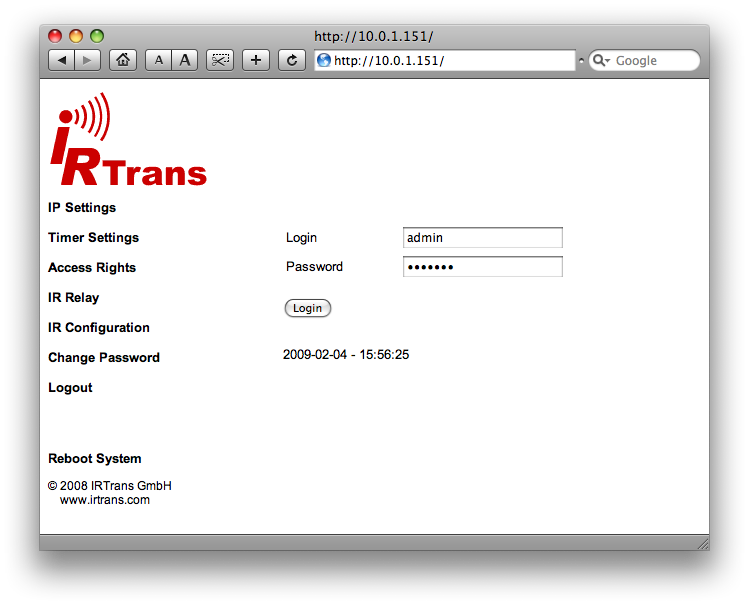You are here
IRTrans - LAN
In the vast majority of installations, the IRTrans LAN module works out-of-the-box, and nothing has to be configured at all.
However, the easy setup requires an DHCP server running in your network. DHCP assures that your IRTrans module gets an IP address which fits into your network. DHCP is a pretty common function of a (Wi-Fi) router, so in most cases you don't have to think about IP addresses.
By default, the IRTrans module looks for an DHCP server on the network. If none is found, the module falls back to the IP 192.168.0.32.
Please note that dynamic IP addresses as provided by DHCP servers may lead to problems: the module will not be found in certain network configurations. Please consider to use a static (manual) address instead. There is a nice bonus: with static IP addresses, the IRTrans module will be found much faster (at least in iRed2, iRedTouch coming).
1st Check: module is working at all?
Make sure that you have connected the IRTrans to a proper power supply. The electrical specifications can be found in the PDF which comes with the module or online: IRTrans Ethernet Manual. When connecting to power, the LED of the module should flash green/red once. Now, even without any software involved, the module must respond to any incoming IR command:
- take any of your IR remotes
- hold the remote towards the IRTrans (1-20 ft.)
- press any key on the remote
- -> the IRTrans should flash green once or as long as you hold down the remote's button
If this basic check is not working, you have a problem with the power supply or the module is defective. While this is very unlikely, please contact info@irtrans.com in that case.
No DHCP server? Need manual IP address?
The IRTrans falls back to the IP 192.168.0.32 if no DHCP server is found. To configure the IRTrans you need to connect to the module's webserver: "http//192.168.0.32". However, if your PC/Mac is not on the same network segment, i.e. the IP address differs in more than the last digits (192.168.0.XXX), then you will not be able to connect to the module.
If you are running Mac OS X 10.5 (Leopard), please see "IRTrans LAN setup on Leopard", where you are guided to change your Mac's IP network settings.
Configuration
Most of the configuration can be done using a web browser.
Just enter the IP address of your module into a web browser like Safari or Firefox and you are brought to the login page:

By default the username/password is admin/irtrans. You can change that password, of course.
Details on all options can be found in the supplied PDF manual which cames with the module, or online: IRTrans Ethernet Manual.
Sometimes the web interface get messed up in Safari. Then you may have to reload the page and/or log into the module again. These problems seems not to occur with Firefox3, though.
IP address unknown?
Well, the IRTrans should get the IP address from a DHCP server on your network. Which address it actually get, depends on your settings. If you rather want to give it a fixed address, please go to the page IRTrans - LAN setup on Leopard.
If you are familiar with the Terminal, you may download the commandline tool "irserver" (irserver.zip, 204 KB).
After unzipping irserver.zip into your home folder, quit iRed (!), copy/paste the following line into your Terminal window and press RETURN:
~/irserver -remotes "/tmp" lan
The output shows the IP address of all connected LAN modules:
IRServer Version 6.01.04
[ 0]: IRTrans LAN: IR VER: E6.02.03 ETH VER: L1.07.01 SN: 22889
MAC:00-xx-xx-xx-xx-xx IP Addr: 10.0.1.151To stop the execution of this tool, press Control-C.
If there are no modules recognized at all, then your network setting may prevent irserver from working properly. Try to temporarily deactivate superfluous network adapters (e.g. virtual ethernet adapters created by Parallels), then run irserver again. Sorry, there is no general recipe for that.
